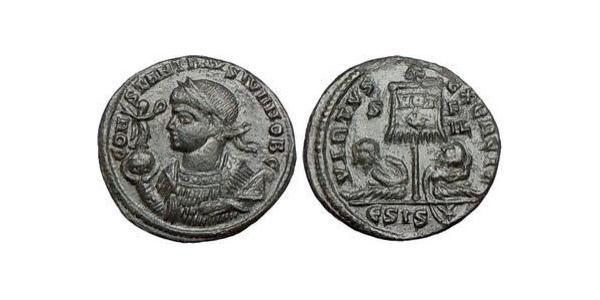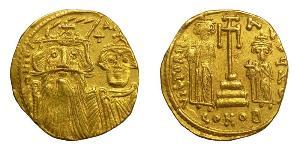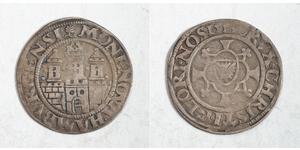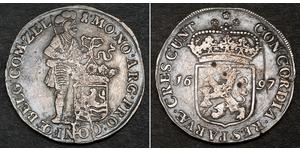[ 3214] Constantine II 'Junior' - Roman Emperor: 337-340 A.D. Bronze Follis (19mm, 3.32 gm) Siscia mint, 2nd officina, Struck 320 A.D. Superb and Rare Reference: RIC VII 133 CONSTANTINVS IVN NOB C, Laureate and cuirassed full bust left, holding Victory on globe and mappa. VIRTVS EXERCIT, Vexillum inscribed VOT/X in two lines; below captive seated to either side; S-F/HL monogram//BЄSIS(star in crescent). Provided with Certificate of Authenticity. CERTIFIED AUTHENTIC by Sergey Nechayev, PhD - Numismatic Expert Flavius Claudius Constantinus, known in English as Constantine II, (316-340) was Roman Emperor from 337 to 340. The eldest son of Constantine the Great and Fausta, he was born at Arles, and was raised as a Christian. On March 1, 317, Constantine was made Caesar, and at the age of seven in 323, took part in his father's campaign against the Sarmatians. At the age of ten he became commander of Gaul, after the death of his half-brother Crispus. An inscription dating to 330 records the title of Alamannicus, so it is probable that his generals won a victory over the Alamanni. His military career continued when Constantine I elected his son field commander during the 332 campaign against the Goths. Following the death of his father in 337, Constantine II became emperor jointly with his brothers Constantius II and Constans. After the division of the empire, made by the three brothers in September of the same year in Pannonia, he ruled over Gaul, Britannia and Hispania. He was involved in the struggle between the different Christian streams. The Western portion of the empire leaned towards Catholicism and against Arianism, and Constantine freed Athanasius and allowed him to return to Alexandria. This action also put some burden on Constantius II, who was a supporter of Arianism. At first, he was the guardian of his younger brother Constans, whose portion was Italia, Africa and Illyricum. As Constans came of age, Constantine would not relinquish the guardianship and in 340 he marched against Constans in Italy, but was defeated at Aquileia and he was killed in an ambush in Cervignano del Friuli. Constans came to control his deceased brother's realm.The Celts were an Indo-European and ethno-linguistically diverse group of tribal societies in Iron Age and Roman-era Europe who spoke Celtic languages. The earliest archaeological culture that may justifiably be considered as Proto-Celtic is the Late Bronze Age Urnfield culture of central Europe from the last quarter of the second millennium BC.[2] Their fully Celtic[2] descendants in central Europe were the people of the Iron Age Hallstatt culture (c. 800-450 BC) named for the rich grave finds in Hallstatt, Austria.[3] By the later La Tène period (c. 450 BC up to the Roman conquest), this Celtic culture had expanded over a wide range of regions, whether by diffusion or migration: to the British Isles (Insular Celts), France and The Low Countries (Gauls), much of Central Europe, the Iberian Peninsula (Celtiberians, Celtici and Gallaeci) and northern Italy (Golaseccans and Cisalpine Gauls)[4] and following the Gallic invasion of the Balkans in 279 BC as far east as central Anatolia (Galatians).[5] The earliest directly attested examples of a Celtic language are the Lepontic inscriptions, beginning from the 6th century BC.[6] Continental Celtic languages are attested only in inscriptions and place-names. Insular Celtic is attested from about the 4th century in ogham inscriptions, although it is clearly much earlier. Literary tradition begins with Old Irish from about the 8th century. Coherent texts of Early Irish literature, such as the Táin Bó Cúailnge (The Cattle Raid of Cooley), survive in 12th-century recensions. By mid 1st millennium AD, following the expansion of the Roman Empire and the Great Migrations (Migration Period) of Germanic peoples, Celtic culture and Insular Celtic had become restricted to Ireland, to the western and norther ...
type to read more

|
Posted by:
anonymous 2015-08-19 |
Similar Coin Groups
2025-05-25
- New coin is added to 1 Ducat Dutch Republic (1581 - 1795) Silver
1 Ducat Dutch Republic (1581 - 1795) Silver
group has 10 coins / 9 prices
⇑
1697, Netherlands, Zeeland Province. Large Silver Knight Ducat Coin. Damaged! Mint Year: 1785 Denomination: Silver Knight Ducat Province: Zeeland (mint mark: castle) Reference: Davenport 49 ...
2025-05-25
- Historical Coin Prices
You may be interested in ...














-300-150-nf4K.GJAcbQAAAEu7g61Lgu3.jpg)







